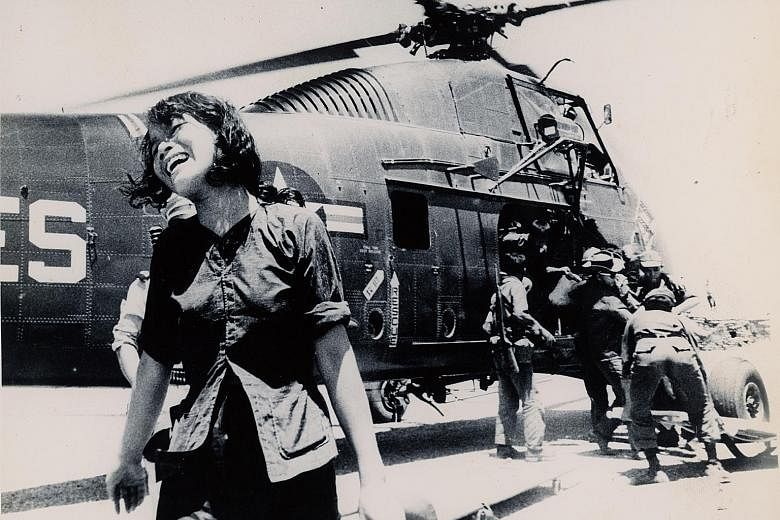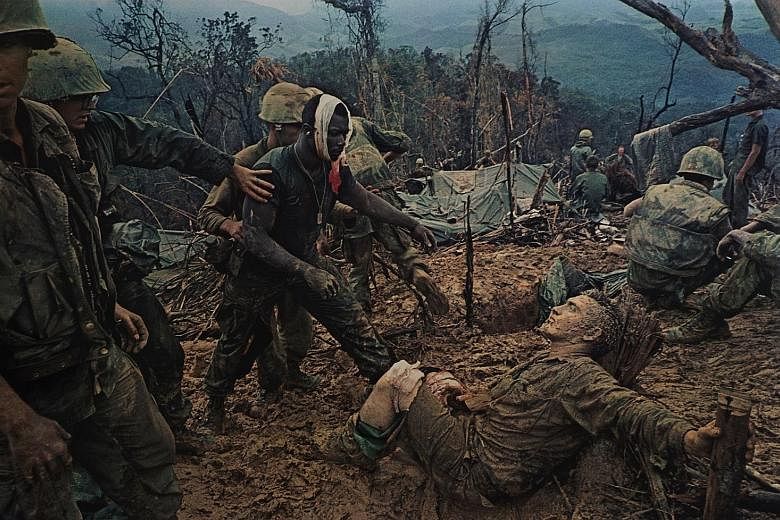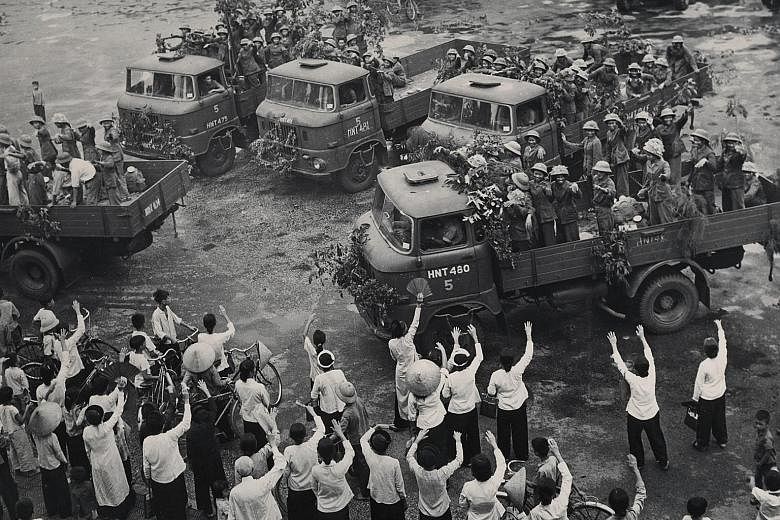Veteran war photographer Tim Page was wounded several times in the Vietnam War - including being hit in the face by a grenade - but his thirst for danger kept driving him back into the thick of the action.
"I had to come back. It was like an addiction... an incredible adrenaline rush," says the 74-year-old, who spent his early 20s in Vietnam as a photographer and made a name for himself with his iconic pictures of the conflict.
Ten photos by the British-born photographer are on display at the Selegie Arts Centre in Singapore, ranging from a shot of Marines landing on Red Beach in Danang, to a woman mourning her husband who was killed in action.
They are part of an exhibition of photos from the Indochina Wars - a series of wars fought in South-east Asia from 1946 onwards.
Most of the 85 photos were taken between 1950 and 1975, a period that covers part of the First Indochina War - also known in Vietnam as the Anti-French Resistance War - and the subsequent Vietnam War, which lasted till 1975.
Among them are Don McCullin's iconic image of a shell-shocked Marine (1968) and Larry Burrows' famous picture, Reaching Out (1966), where an injured Marine is drawn to his comrade. There are other pieces by famous photojournalists including American David Douglas Duncan, Hungarian Robert Capa and Welshman Philip Jones Griffiths.
-
VIEW IT/ BATTLEFIELD LENS PHOTOGRAPHERS OF INDOCHINA WARS 1950-1975
-
WHERE: Loke Wan Tho Gallery, Level 3, Selegie Arts Centre, 30 Selegie Road
WHEN: Till April 10, noon to 8pm
ADMISSION: Free
INFO: The exhibition is organised by creative agency Phish Communications and The Photographic Society of Singapore. For more information, go to facebook.com/pss1950sg/ or e-mail judith.lee@pss1950.org
About a dozen rarely seen shots by North Vietnamese photographers such as Dinh Ngoc Thong and Mai Nam will feature in the exhibition too. One image by Tran Cu, for example, shows Pioneer Youth volunteers in 1971 leaving Hanoi for Ho Chi Minh Trail, a system of trails which North Vietnam used to send troops and supplies into South Vietnam, Cambodia and Laos during the Vietnam War.
All the photos - mostly vintage prints - are from the collection of Singaporean retiree Judd Kinne, 74, who was a United States Marine Corps infantry officer in South Vietnam from 1967 to 1969.
The photos deal with heavy issues - the devastating effects of war on soldiers and civilians; the humanity that transcended the atrocities. Occasionally, they are leavened by black humour.
Mr Kinne points to a vintage gelatin silver print by news agency United Press International photographer Charles Eggleston, taken in Con Thien, 1967, showing an American soldier who penned an inscription on his helmet cover. "Where is Lee Harvy Oswalt (sic) now that we really need him," it read, a sardonic nod to the ex-Marine who assassinated former United States president John F. Kennedy.
"Most people used to write stuff on their helmet covers," Mr Kinne says. "A lot of guys would draw an elaborate calendar because we served 13-month tours, and a lot of guys would tick off each day till they left, hopefully alive."
Some Singaporean photographers - Terence Khoo, Sam Kai Faye and Chellappah Canagaratnam - were killed during the Vietnam War. Mr Kinne does not have their photos.
Mr Kinne left the Marine Corps in 1969. He headed to business school and then moved to Singapore in 1973, where he found a job in the financial services sector.
Fifteen years ago, he started collecting photos of the Indochina Wars and has since amassed about 400 of them. One of the images on display, taken in 1968, shows him posing with his command group in a village south of the Vietnamese Demilitarised Zone (DMZ) which divided North and South Vietnam.
Many other photos were taken in locations close to where Mr Kinne was or by people he met in real life.
In 1969, he was attached to a small advisory team in Hoi An, south of Danang. One evening, a British photographer shooting for Life magazine arrived from the field.
"He changed for dinner, put a cravat on and very quietly spoke to people," Mr Kinne recalls.
The man turned out to be the famous photographer Larry Burrows, who would die in a helicopter crash over Laos two years later.
Photographer Page, who regarded Burrows as his mentor, was no stranger to near-death experiences himself. He was wounded at least four times in the Vietnam War and once shot a man.
"I only had to use (a gun) once. It was in a Special Forces camp on the Cambodian border. The camp was being overrun and there was a Viet Cong 20m away throwing grenades," he says.
He killed the man to defend himself. "It's not a good thing to do, but it's you or me."
His time in Vietnam came to an end in 1969, after his head was hit by shrapnel when the man in front of him stepped on a land mine.
"I wasn't able to do anything for six or seven years," says Page, adding that part of his brain was removed and his guts came out.
"I was on a lot of medication. Anti-epilepsy, anti-pain... For a year, I was hemiplegic. I was shot on the left side, so my right side was paralysed," says the veteran photographer, who now lives in Australia.
What advice does he have for people who want to become war photographers?
"Don't," he says.
"It's a fool's game. It's very hard to make a living as a photographer these days because everybody's got a device, an iPhone. And it doesn't pay anything. If you go to Syria and get caught up in the war, you might get US$70 (S$95) for a picture. How do you exist on that, how do you cover the insurance? How can you afford to go there as a freelancer?"
Mr Kinne hopes the exhibition will shed light on the skill of the war photographers who documented the Indochina Wars.
He adds: "For your average Singaporean two generations younger than me, Vietnam is probably a tourist destination.There are many younger people who know very little about these wars... I hope (the exhibition) might be a catalyst for them to learn more."





